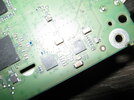At this point I have more questions than suggestions. If you can change SXM channels and the display shows the currently playing SXM song name, the tuner must have switched to SXM and that channel, right? Plus the tuner must be sending channel and song name data to the MCU. But it's still playing the last tuned FM channel? Why would the FM stream even be playing if the tuner is in SXM mode. It doesn't seem likely that both the FM and SXM tuners could be active at the same time and both transmitting data streams simultaneously over ethernet.
I suppose it's possible that there are two tuners in the module and they both dump their datastream continuously, then the MCU simply picks one of the two streams to pipe through the speakers. Although it just seems odd that FM and SXM data streams would be "live" continuously: what purpose would that serve unless it was just easier to code it that way? Although I guess that could explain how the last FM channel is heard: that datastream is still active and for whatever reason the MCU is unable to pick the SXM stream as an input.
It seems like you are close if the above is true: the SXM tuner may be tuning to the proper channel and the SXM data stream might be there... the MCU just can't access that stream: almost as if the UI should be telling it to switch to the SXM data stream but the "listener" part of the code is saying "What? Bad address/file" thinking that's an invalid stream for a Model 3.
Mike
I suppose it's possible that there are two tuners in the module and they both dump their datastream continuously, then the MCU simply picks one of the two streams to pipe through the speakers. Although it just seems odd that FM and SXM data streams would be "live" continuously: what purpose would that serve unless it was just easier to code it that way? Although I guess that could explain how the last FM channel is heard: that datastream is still active and for whatever reason the MCU is unable to pick the SXM stream as an input.
It seems like you are close if the above is true: the SXM tuner may be tuning to the proper channel and the SXM data stream might be there... the MCU just can't access that stream: almost as if the UI should be telling it to switch to the SXM data stream but the "listener" part of the code is saying "What? Bad address/file" thinking that's an invalid stream for a Model 3.
Mike



